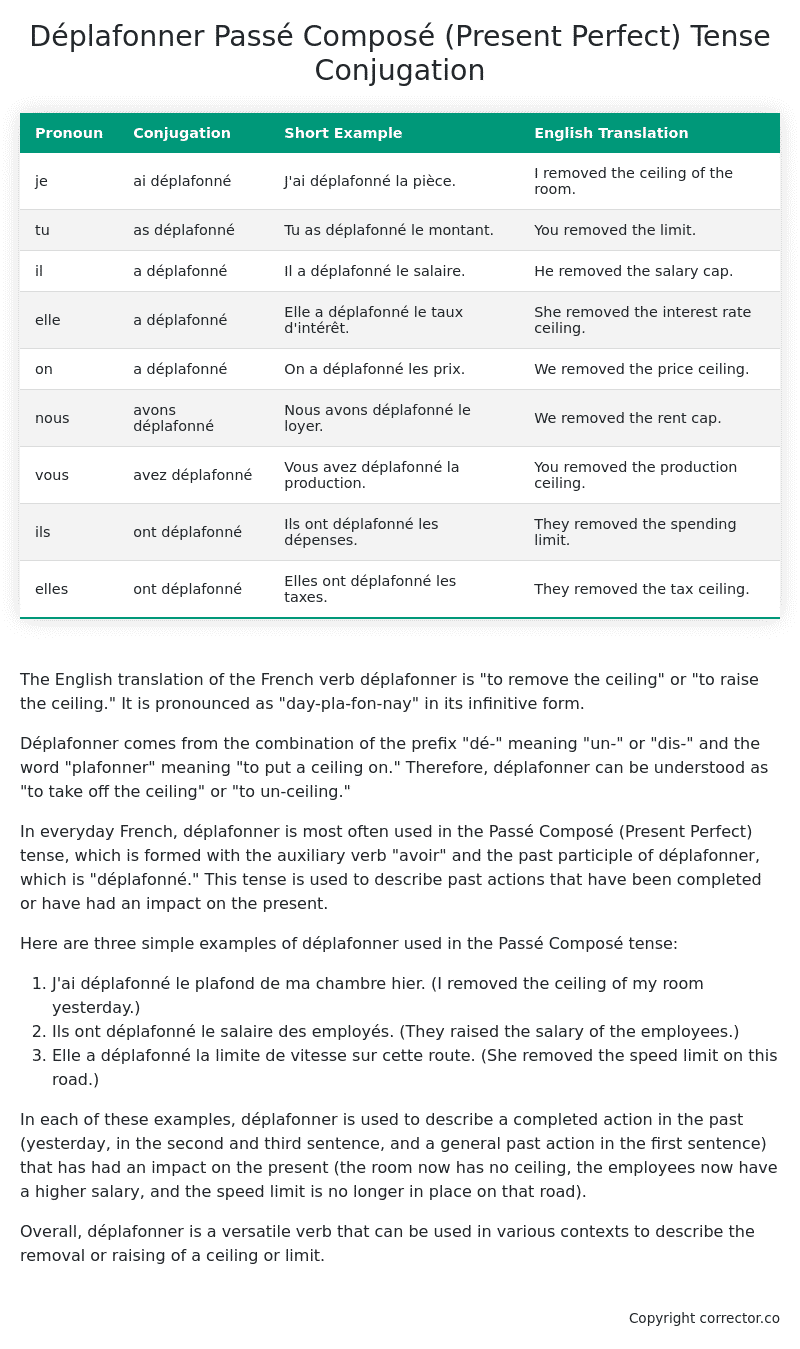Passé Composé (Present Perfect) Tense Conjugation of the French Verb déplafonner
Introduction to the verb déplafonner
The English translation of the French verb déplafonner is “to remove the ceiling” or “to raise the ceiling.” It is pronounced as “day-pla-fon-nay” in its infinitive form.
Déplafonner comes from the combination of the prefix “dé-” meaning “un-” or “dis-” and the word “plafonner” meaning “to put a ceiling on.” Therefore, déplafonner can be understood as “to take off the ceiling” or “to un-ceiling.”
In everyday French, déplafonner is most often used in the Passé Composé (Present Perfect) tense, which is formed with the auxiliary verb “avoir” and the past participle of déplafonner, which is “déplafonné.” This tense is used to describe past actions that have been completed or have had an impact on the present.
Here are three simple examples of déplafonner used in the Passé Composé tense:
- J’ai déplafonné le plafond de ma chambre hier. (I removed the ceiling of my room yesterday.)
- Ils ont déplafonné le salaire des employés. (They raised the salary of the employees.)
- Elle a déplafonné la limite de vitesse sur cette route. (She removed the speed limit on this road.)
In each of these examples, déplafonner is used to describe a completed action in the past (yesterday, in the second and third sentence, and a general past action in the first sentence) that has had an impact on the present (the room now has no ceiling, the employees now have a higher salary, and the speed limit is no longer in place on that road).
Overall, déplafonner is a versatile verb that can be used in various contexts to describe the removal or raising of a ceiling or limit.
Table of the Passé Composé (Present Perfect) Tense Conjugation of déplafonner
| Pronoun | Conjugation | Short Example | English Translation |
|---|---|---|---|
| je | ai déplafonné | J’ai déplafonné la pièce. | I removed the ceiling of the room. |
| tu | as déplafonné | Tu as déplafonné le montant. | You removed the limit. |
| il | a déplafonné | Il a déplafonné le salaire. | He removed the salary cap. |
| elle | a déplafonné | Elle a déplafonné le taux d’intérêt. | She removed the interest rate ceiling. |
| on | a déplafonné | On a déplafonné les prix. | We removed the price ceiling. |
| nous | avons déplafonné | Nous avons déplafonné le loyer. | We removed the rent cap. |
| vous | avez déplafonné | Vous avez déplafonné la production. | You removed the production ceiling. |
| ils | ont déplafonné | Ils ont déplafonné les dépenses. | They removed the spending limit. |
| elles | ont déplafonné | Elles ont déplafonné les taxes. | They removed the tax ceiling. |
Other Conjugations for Déplafonner.
Le Present (Present Tense) Conjugation of the French Verb déplafonner
Imparfait (Imperfect) Tense Conjugation of the French Verb déplafonner
Passé Simple (Simple Past) Tense Conjugation of the French Verb déplafonner
Passé Composé (Present Perfect) Tense Conjugation of the French Verb déplafonner (this article)
Futur Simple (Simple Future) Tense Conjugation of the French Verb déplafonner
Futur Proche (Near Future) Tense Conjugation of the French Verb déplafonner
Plus-que-parfait (Pluperfect) Tense Conjugation of the French Verb déplafonner
Passé Antérieur (Past Anterior) Tense Conjugation of the French Verb déplafonner
Futur Antérieur (Future Anterior) Tense Conjugation of the French Verb déplafonner
Subjonctif Présent (Subjunctive Present) Tense Conjugation of the French Verb déplafonner
Subjonctif Passé (Subjunctive Past) Tense Conjugation of the French Verb déplafonner
Subjonctif Imparfait (Subjunctive Imperfect) Tense Conjugation of the French Verb déplafonner
Conditionnel Présent (Conditional Present) Tense Conjugation of the French Verb déplafonner
Conditionnel Passé (Conditional Past) Tense Conjugation of the French Verb déplafonner
L’impératif Présent (Imperative Present) Tense Conjugation of the French Verb déplafonner
L’infinitif Présent (Infinitive Present) Tense Conjugation of the French Verb déplafonner
Struggling with French verbs or the language in general? Why not use our free French Grammar Checker – no registration required!
Get a FREE Download Study Sheet of this Conjugation 🔥
Simply right click the image below, click “save image” and get your free reference for the déplafonner present perfect tense conjugation!

Déplafonner – About the French Passé Composé (Present Perfect) Tense
Formation of the Passé Composé
Set the auxiliary verb with either
Conjugate the auxiliary verb
Add the past participle
Common everyday usage patterns
Narrating Past Events
Sequential Actions
Describing Completed Actions
Interactions with other tenses
Imperfect Tense
Conditional and Future Tenses
Summary
I hope you enjoyed this article on the verb déplafonner. Still in a learning mood? Check out another TOTALLY random French verb conjugation!


